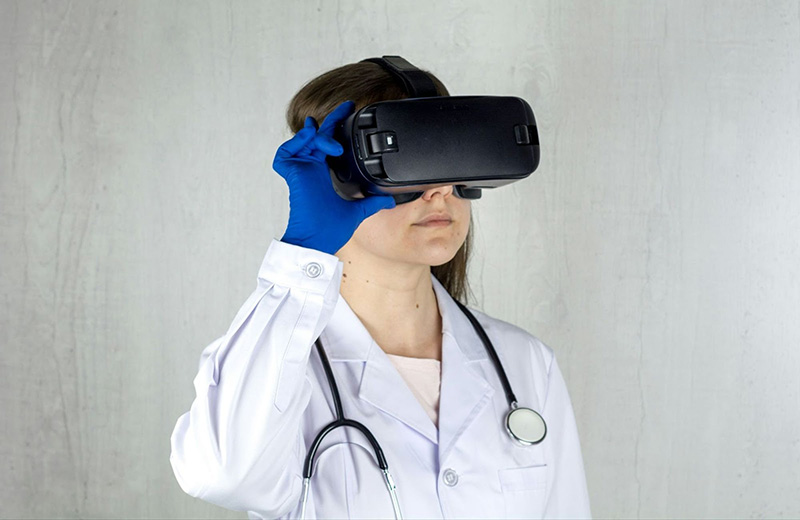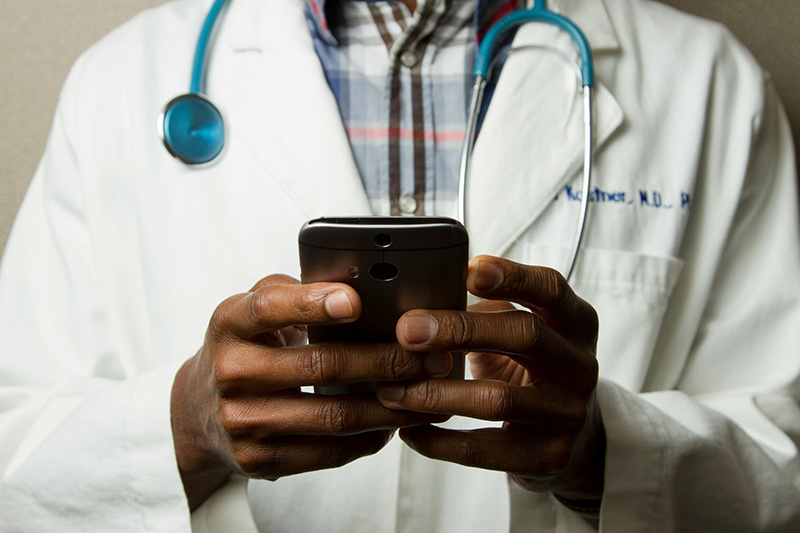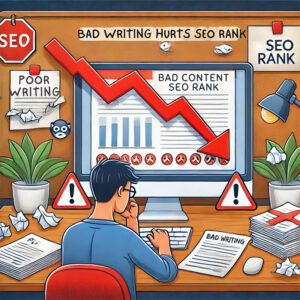In our last episode, we ventured into the brave new world of telemedicine, where waiting rooms are virtual, and Steve no longer holds the power to irk us with his smug entrance to the exam room.
As we waved goodbye to the traditional confines of in-person visits, we couldn’t help but wonder: What’s next?
Strap in, dear readers, for Part 2 of our digital healthcare saga, where we dive headfirst into the murky waters of telemedicine through the eyes of its most critical judges – patients and healthcare professionals.
Imagine, if you will, a world where your doctor’s “good bedside manner” translates to how emotive they can be through a screen. Where stethoscopes meet webcams, and patient confidentiality takes on a whole new meaning in the age of digital eavesdropping.
But fear not, for we’re not just here to poke fun at the quirks of virtual consultations. No, we’re on a quest to uncover what is really being said: What do both sides of the screen think about this shift?
Are virtual visits the healthcare equivalent of streaming services—convenient, personalized, and the new normal?
Or, are they just a stopgap, eagerly awaiting the return of the in-person connection?
As we traverse tales of technological triumphs and tele-tragedies, we’ll end our journey with a gaze into the crystal ball of healthcare. Spoiler alert: We believe it looks like a hybrid model, where digital and physical healthcare coexist in a blissful marriage of convenience and humanity.
So, buckle up, and let’s take this journey together. After all, the future of healthcare might just be a click away.

Patient and Healthcare Professional Perspectives
The adoption and effectiveness of telemedicine are best understood through the experiences and viewpoints of those at its forefront: patients and healthcare professionals. Their insights provide a true understanding of telemedicine’s impact and its place in the healthcare ecosystem.
Patient Perspectives (1):
Recent studies and surveys have shed light on patients’ attitudes towards telemedicine.
The convenience and time-saving aspects are consistently praised, especially by those in remote areas or with mobility challenges. Patients appreciate the ease of accessing medical services without the need for travel or waiting rooms.
However, the experiences aren’t uniformly positive. Some patients express concerns over the perceived impersonality of virtual visits and the difficulty in establishing a strong patient-doctor relationship. There are also apprehensions regarding the effectiveness of diagnoses made remotely, especially for conditions that typically require physical examinations.
For chronic disease patients, telemedicine has been a game-changer. It offers them regular, convenient monitoring and consultation, reducing the need for frequent hospital visits. Mental health services, too, have seen a significant uptick in telemedicine use, with many patients finding it easier to seek help in the familiar environment of their home.
Healthcare Professional Perspectives (1):
Healthcare professionals have had to adapt rapidly to the integration of telemedicine into their practices. Many acknowledge the efficiency it brings, particularly in managing routine consultations and follow-up appointments. It allows them to reach a broader patient base and offers a flexible way to provide care.
However, this transition hasn’t been without its challenges. Concerns about maintaining the quality of care, managing technology, and navigating new workflows are common. Healthcare professionals also emphasize the importance of in-person interactions in certain scenarios, highlighting the limitations of telemedicine.
Despite these challenges, the general consensus among healthcare providers is optimistic. They recognize telemedicine as a powerful tool that, when used appropriately, can enhance the quality of healthcare delivery. It’s seen as a complement to traditional in-person visits rather than a replacement.

The Future of Healthcare: A Hybrid Model?
As we contemplate the future of healthcare, a hybrid model that marries telemedicine benefits with traditional in-person visits emerges as a promising possibility. This integrated approach could potentially offer the best of both worlds, optimizing patient care and resource allocation.
Integrating Telemedicine and In-Person Care:
The hybrid model envisions a healthcare system where telemedicine and in-person consultations coexist and complement each other. For instance, routine check-ups, initial consultations, and follow-up appointments could be effectively handled through telemedicine. Conversely, more complex cases requiring physical examinations, procedures, or in-person diagnostics would still take place in traditional healthcare settings.
This approach recognizes the intrinsic value of face-to-face interactions in certain medical scenarios while leveraging the convenience and efficiency of telemedicine. It also presents an opportunity to personalize healthcare delivery, tailoring it to individual patient needs and preferences.
Benefits of a Hybrid Model (2):
A hybrid healthcare model offers numerous benefits. It could significantly reduce the burden on healthcare facilities, freeing up resources for more critical cases.
Patients would likely experience shorter wait times and increased access to care, especially in underserved areas. Additionally, it could foster a more patient-centered approach, with greater flexibility and control over their healthcare journey.
Telemedicine Disadvantages (2) :
However, implementing a hybrid model is not without its challenges. It requires careful coordination, robust technological infrastructure, and clear guidelines to determine the appropriate mode of care for each patient. There’s also the need for ongoing training and support for healthcare professionals to adapt to this dual approach.
One of the largest concerns is security and privacy. Healthcare entities employing telemedicine solutions must ensure the complete protection of patient privacy, maintain confidentiality, and safeguard against fraud and abuse.
This means offering patients more than a quick and dirty “terms and conditions” form that unbeknownst to them, is a hidden form where they sign away their privacy rights.
While telemedicine is certainly a lucrative business endeavor, balancing this with regular in person visits is a must.
“I can’t tell you how many times patients would come in wanting to talk about an issue, but after examining them, I find something else that is so much more critical. A patient may have an ingrown toenail, for example, but I see how swollen their ankles are, and after ordering the appropriate workup discover they have heart failure. Telemedicine cannot completely replace in-person visits.” -Danielle Kelvas, MD
Telemedicine also runs the risk of turning into an expedited pill mill. Many states require an in-person visit before dispensing prescription medication, but this is rapidly changing. Now, a simple video interview can suffice.
Is it ethical and safe to allow mass prescription medication practices among the masses without comprehensive physical exams?
Ensuring equitable healthcare accessibility to both telemedicine and in-person care is another area that merits consideration. A hybrid model must be inclusive, addressing the digital divide and ensuring that all segments of the population can benefit from this integrated approach.

DKMD Consulting: Your Hub for the Latest in Telemedicine
Ready to revolutionize your healthcare journey with a sprinkle of digital wizardry? Look no further than DKMD Consulting!
Our team of healthcare professionals, medical experts, and seasoned writers is dedicated to crafting clear, compelling, and scientifically accurate content that elevates your healthcare communication to the next level.
Whether it’s giving your website a facelift, ensuring your content’s accuracy, or illuminating complex data with engaging infographics, we’ve got the right combination for success.
With our lifetime update guarantee, your documents stay as fresh as the latest medical breakthroughs, ensuring your content remains relevant and authoritative. So why settle for less when you can partner with DKMD Consulting and experience the pinnacle of healthcare excellence?
Enlist our team of experts for a journey to clearer communication, enhanced credibility, and a stronger online presence today. Visit DKMD Consulting and let’s create meaningful change together. Your digital healthcare renaissance awaits!
References:
- Abdelghany, I. K., AlMatar, R., Al-Haqan, A., & et al. (2024). Exploring healthcare providers’ perspectives on virtual care delivery: Insights into telemedicine services. BMC Health Services Research, 24*(1).
- Haleem, A., Javaid, M., Singh, R. P., & Suman, R. (2021). Telemedicine for healthcare: Capabilities, features, barriers, and applications. Sensors international, 2 , 100117.





